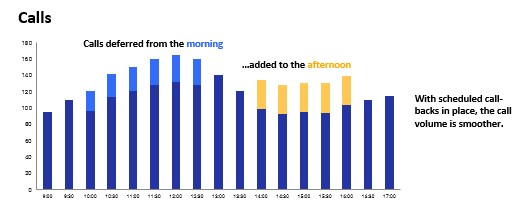Does your call center feel more like a burden than an asset? You’re not alone — contact center managers often find themselves faced with tough challenges, including clunky technology, dysfunctional processes, and less-than-happy customers.
How can you turn your contact center into a highly efficient part of your business?
The first step is to consider the root problems — the vast majority of challenges you will encounter boil down to customer experience, call distribution, technology, and the well-being of your agents.
Once you’ve identified your target issues, it’s time to take action!
We’ve outlined some essential steps to help you transform your contact center into a streamlined operation where your agents can thrive.
1. Evaluate your call center’s operational needs regularly
Contact center efficiency doesn’t happen overnight — it’s something that will require a lot of thought and strategic input from management, as well as your agents. Most businesses will take the “reactive” approach, and only take action when an issue becomes too large to ignore; this often results in makeshift solutions and hasty restructuring, which will likely spawn more problems down the road.
Our advice? Take a proactive approach instead, and evaluate your contact center’s needs and procedural pain points on a regular basis. Are your agents answering the same questions repeatedly? Is your call abandonment rate on the rise?
Gaining an overview of your contact center’s challenges will allow you to consider solutions that will address multiple issues, rather than individual “band-aid” fixes.
FACT:
According to this study by Cornell University, replacing a single contact center agent will cost the average employer 16% — or 2 months — of a typical worker’s pay.
2. Keep turnover low to improve the agent experience
Your agents are the heart and soul of your contact center. So it only makes sense for you to invest in hiring and retaining the best agents. However, contact centers are notorious for having high turnover rates — approximately 30-45%, according to the Quality Assurance & Training Connection (QATC).
If you’ve been dealing with high turnover for a while, it’s easy to shrug your shoulders and think “this is just the way things are”. But the reality is, most agents don’t just leave because they’ve had a change of heart — more often, it is a carefully made decision based on their job conditions.
The good news is that you have influence over their experience. The first step is to find out why your agents are leaving. You might be surprised at the reasons you discover!
Here are some of the most common reasons for employee departure in contact centers, as well as some helpful solutions:
They’re not a good fit
Like any role, call center agents need to be suited to the work they do. They need to be highly organized, ask the right questions, and a strong communicator to answer customer inquiries.
It’s difficult to set a hasty hire up for success, especially if they are not equipped with the basic qualifications. This can result in demotivation, which can lead them to search for other opportunities.
You may be inclined to think, “Well, I’ll just hire someone who has contact center experience!” While it may seem like a foolproof approach, it’s important to remember different contact centers will have different expectations, goals, and challenges. Be transparent about expectations for any sales targets, busy seasons, and customer profiles so your new hire can make an informed decision about whether this role will be a good fit for them.
DID YOU KNOW? According to this study by the University of Toronto, call center employees who were exposed to motivational images and posters in their work area were 33% more successful in their performance and raised 60% more pledges than those who worked without similar imagery.
Lack of training and support
Hiring the right agents for the job isn’t enough. If they feel like they’re just another number that management doesn’t care about, they’re bound to stop caring as well. By providing thorough, proper training upon hire, they will know that you value their contribution and that they have the support of their employer to do a great job.
Onboarding training isn’t the only thing you should consider. By providing regular learning opportunities for all your agents, you can help them sharpen their skills in customer service and communication. This will give you opportunities to check in with their progress and keep your agents engaged in the work that they do.
Stress and burnout
This is one of the most common reasons for employee turnover. In fact, according to Toister Performance Solutions Inc., a staggering 74% of call center agents are at risk of burnout.
The above report also highlights some insightful trends:
- “52% of agents who are at severe risk of burnout said their company is not customer-focused.”
- “41% of agents who are at severe risk of burnout say they don’t feel empowered.”
- “36% of agents with a severe burnout risk think their coworkers don’t provide outstanding service.”
These metrics speak volumes to how essential a supportive and healthy workplace is when it comes to hiring and retaining a strong call-center team. By putting employee welfare on your priority list, you can cultivate a culture that will make your staff want to stay and grow with your business!
3. Equip your agents with the right tools
If you want to drive a nail into a piece of wood, a hammer is the best tool for the job. But if you don’t have the right tool, that job becomes needlessly challenging and difficult.
Yet, so many call centers expect their agents to achieve top results with inefficient programs, clunky systems, and outdated information. Don’t leave your employees hammering with a rock — set them up for success by giving them the tools they need to hit their targets!
Here are some good places to start:
Give them access to important information
Almost every contact center agent knows that dreaded feeling of being faced with a customer without having the proper information — or worse, not knowing whether their information is correct.
Your contact center agents are viewed as specialists by your customers; they’re expected to have all the right answers and solutions to their problems. If they’re not armed with the most up-to-date information, they’ll be forced into an awkward situation time and time again. It’s a lose-lose for your agents and your customers.
It’s up to your call center’s management to ensure that their agents or reps are confident about the product or service you provide. Provide regular updates and update best practices so your team is on the same page as the rest of the organization.
In addition, encourage your agents to come forward with common questions, inquiries, and challenges that they encounter in their daily work. They are on the front lines and have great insights on customer experiences, which will help you streamline your team’s efforts.
TIP: Consider providing an internal chat system to your contact center agents so they can communicate while on the line with customers. This can help them source answers from their fellow agents quickly if they’re in a bind.
Consider flexible work options
Thanks to COVID-19, the vast majority of professionals have shifted to remote work. This has been the case for many call center agents, as companies have invested in the equipment and infrastructure to allow their teams to work from home.
While this might not be an option for every business, it’s definitely something to consider. Remote work is a great option when it comes to cost-effectiveness. It also allows you to expand your choice of hires, work more flexible hours, and reduces office overheads
However, there are also challenges that come with it, such as remote training and management. Plus, it can be difficult to create a positive team culture with your agents spread out. Evaluate the pros and cons carefully to decide whether this is the right move for your business.
Invest in an integrated system
If your call center agents are wasting valuable time switching between multiple spreadsheets and programs, it’s time for you to upgrade to an integrated system.
Not only does this help with call distribution and smoothing call spikes — which we’ll delve further into in the next section — it’ll combine all the essential functions your team needs into one easy-to-use platform. This can include scheduling, voice call-backs and SMS, and performance metrics. We promise, your agents will thank you!
4. Invest in call distribution technology
High call volume is one of the most challenging things that your contact center agents will face. In past, this was just considered part of the job but now, things have changed. Technology has gotten smarter, and so have we!
Call distribution technology is the key to helping your team perform at their best, even at the most demanding times. It’s worth your time as a contact center manager to review the effectiveness of the tools you have on hand. Here are some areas to get you started:
Review your IVR
The first step is to review the options on your IVR and ensure that it’s up to date. Consider the customer journey — is your IVR’s menu optimized to direct the flow of callers? Is the language clear enough so your customers can navigate with ease?
If one of your departments is constantly getting inquiries about something that should be directed to a different department, it might be time to evaluate your menu options.
Consider a callback solution
There are a few things that customers hate more than waiting on hold, however, during peak periods it’s an unavoidable reality. The result? High call abandon rates and lots of unhappy customers.

The above chart showcases how call-back technology can be used to manage high volume inquiries in your contact center. (Image: Fonolo, 2020)
Call-backs are one of the most effective ways of handling unexpected call spikes and high contact volume. But programmable call-backs are an essential tool for the busy call center.
You can drastically improve the efficiency of your contact center by offering call-backs anywhere — on your website, internally, or through any of your existing platforms. This helps relieve the pressure on your workers, reduce call abandon rate, and keeps your customers happier.
Create additional self-service channels
Curating a list of Frequently Asked Questions (FAQ) or an online help center is another great way to ease the pressure from your agents. This will help your customers access the information they need with a quick search, so your team can focus on solving more complex questions.
This can be a simple page on your website, or you can invest in a more robust tool like Zendesk. Again, the first step is to source the most common questions and inquiries from customers, so take some time to compile some research. The time your self-service portal will save you in the coming months will make it well worth it.

Discover the Contact Center Trends That Matter in 2024
Dig into industry trends and discover the changes that matter to your business in the year ahead.
